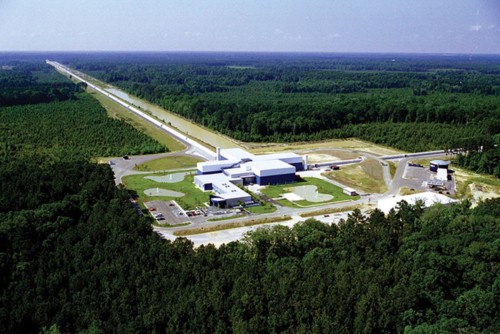
The LIGO detectors in Louisiana (above) and Washington are currently being upgraded. (Courtesy: LIGO/Caltech)
By Hamish Johnston at the APS April Meeting in Salt Lake City
I came to Salt Lake City hoping to glean a few golden nuggets of information about what future gravitational-wave detections we can expect from LIGO. What I found is that the collaboration is as tight-lipped as ever about discussing potential results. That’s fair enough and I understand the caution. However, I was hoping that the researchers would have loosened up a bit after their February announcement of the first gravitational-wave detection and share a little more with the general public.
So, what have I learned?
Peter Fritschel of MIT explained that the collaboration’s two huge detectors are now being upgraded following their first run from September 2015 to January 2016. This run was actually extended by a month because the first detection was made in September and the team was hoping for another before shutting down.
The second run will begin this autumn with a higher sensitivity, which could allow LIGO to make a detection once a month. Then there will be a second upgrade, which could equip LIGO to detect one gravitational wave a week. This would allow astronomers to build up a gravitational image of the sky – a very exciting prospect.
Regarding LVT151012, which is a signal measured by LIGO in the first run. It is too weak to be declared a gravitational-wave detection because it has a statistical significance of just 2σ, which is well below the 5σ needed for a discovery. However, Penn State’s Chad Hanna points out that the signal appears to have a”chirped” waveform, which is consistent with two merging black holes.
Hanna also mentioned that LIGO physicists have only published results from about a third of the first run data. So, there could be some interesting discoveries announced before the experiment fires up agin in the autumn.
So what wavelength range are we getting with the gravitational wave detection? Or is that secret?
http://physicsworld.com/cws/article/print/2007/jun/01/sounding-out-the-big-bang
You might find relevant Figure 1 in the article.
This work will be only validated with detection findings from a LIGO world array, can’t wait…MFM